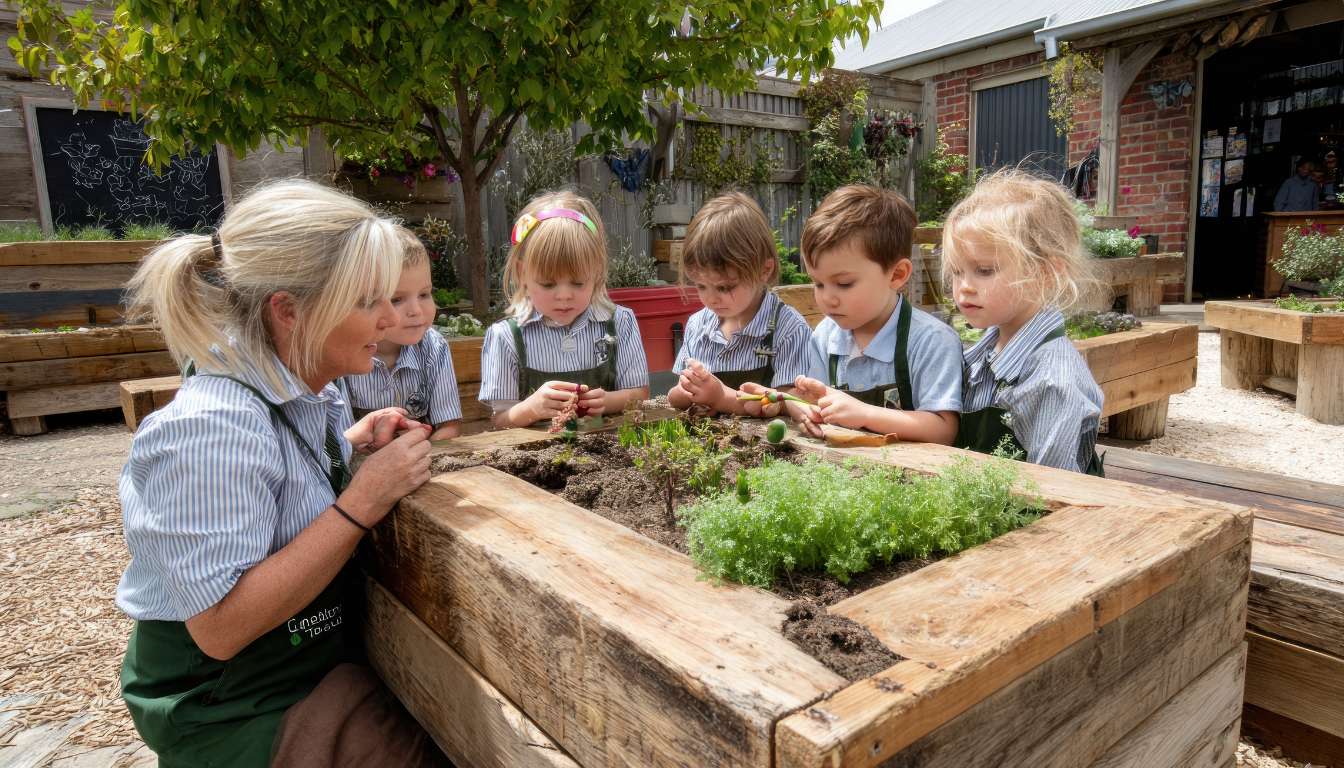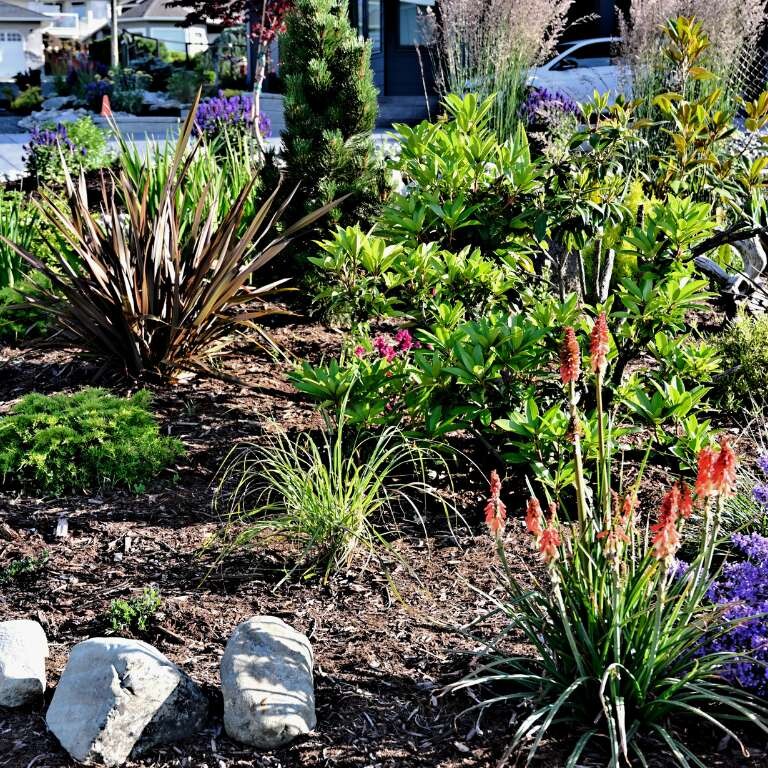How to involve children in gardening – learning through play and enjoying the results

Tips and tricks
If you want to transform your exterior into the garden of your dreams, don’t forget to involve even the youngest members of your family in the process. How to involve children in gardening? Gardening is a great way to spend time together, teach children new skills, and encourage their relationship with nature. When designing a turnkey garden, we recommend leaving space in the project where children can express their creativity.
Why working in the garden with children is special
How to involve children in gardening? Working together in the garden develops the senses, teaches patience, promotes healthy exercise, and creates unforgettable experiences. Children perceive garden design and its elements through discovery, experimentation, and observation of change—whether it’s growing plants, watering the lawn, creating decorative stepping stones, or regular garden maintenance.
7 tips and activities for getting kids involved in a playful way
- Set aside a separate flower bed: Give children a piece of the garden to experiment with, for example, planting fast-growing herbs or flowering plants.
- Plant Mediterranean plants: Explain to them how overwintering and caring for exotic species works.
- Involve them in watering: Children love working with water, whether it’s caring for the lawn or watering plants.
- Raking hay, leaves, or grass: Combine outdoor exercise with practical tasks that are both fun and beneficial.
- Tasting the harvest: Gardening is not just work, but also the joy of seeing results – fresh fruit or vegetables will delight every little helper.
- Creating decorative elements: Painting stones, making a mini garden, or building wooden steps for a garden house.
- Keeping a garden diary: You will encourage curiosity and creativity and practice writing, drawing, and photographing your own projects.

Learning through play and enjoying the results
Inspire your children with simple little projects that will give them quick results – whether it’s flowering plants, a carpet of grass, or their own mini vegetable garden. Through play, you can teach them the principles of garden design and how all the elements of a garden are connected. If you don’t feel confident about creating a complete garden, consult a professional. Also, don’t forget about regular maintenance and innovations, which can be a motivating experience for children.
When planning and building your dream family garden, keep in mind that the time spent working together with your children is the best investment in the future. With Dream Garden, you can create a space for learning, fun, and beautiful experiences for the whole family.
Similar posts
How to overwinter Mediterranean plants and prepare them for the next season

Tips and tricks
Mediterranean plants bring a holiday atmosphere to our gardens – the scent of the sea, sun, and south. How to overwinter Mediterranean plants? Olive trees, oleanders, lavender, and citrus trees have become an integral part of modern garden design. But while they survive the winter without any problems in the Mediterranean, they need special care here to wake up to their beauty again in the spring.
Why overwintering is important
If you dream of having your own dream garden full of exotic greenery, winter care is key. How to overwinter Mediterranean plants? Mediterranean plants such as oleander, olive trees, citrus fruits, rosemary, and lavender come from warm regions, so they do not tolerate prolonged frosts well. Proper winterization is essential if you want to use them in your garden in our region.
The right conditions for overwintering
- Light and heat: Plants such as oleander and citrus trees require a bright location with a temperature between 5 and 12 °C. Ideally, they should be moved to a winter garden, garage, or basement with a window.
- Watering: Water plants only lightly during winter – the soil should remain slightly moist, not soggy.
- Protection from frost: If the plants are planted in a flower bed, cover them with gardening fabric, straw mats, or a layer of leaves.
- Citrus and olive trees in pots: Bring them indoors before the first frost. In cold areas, it is advisable to grow them in mobile containers that can be easily moved.
Ideal species for a turnkey garden
If you are planning a turnkey garden, Mediterranean plants can transform your outdoor space beyond recognition. Recommended species for Slovak conditions are:
- European olive tree (Olea europaea) – a symbol of the south, suitable for growing in pots.
- Oleander (Nerium oleander) – blooms all summer, but cannot tolerate frost.
- Rosemary (Rosmarinus officinalis) and lavender (Lavandula angustifolia) – more resistant species that can be grown even in soil with minimal protection.
- Lemon tree (Citrus limon) – a popular decorative tree that can bear fruit indoors during the winter.

Stredomorská atmosféra aj počas zimy
Súčasťou profesionálneho záhradného dizajnu je aj plán starostlivosti o rastliny počas celého roka. V Dream Garden pri tvorbe každej záhrady snov kladieme dôraz nielen na krásu, ale aj na funkčnosť a trvácnosť. Pomáhame klientom s údržbou a zazimovaním rastlín tak, aby ich exteriér žil naplno počas každej sezóny.
Pripravíme aj vašu záhradu na zimu
Ak máte v záhrade stredomorské rastliny a nie ste si istí, ako im pomôcť prečkať zimu, obráťte sa na nás. Radi navrhneme riešenie pre ich ochranu alebo sa postaráme o kompletnú realizáciu záhrady na kľúč, ktorá bude krásna a praktická po celý rok.
Similar posts
How to prepare your garden in autumn: what to do now so that it comes to life in all its glory in spring

Tips and tricks
Autumn is the time when the garden slowly settles down for a rest. How to prepare your garden for autumn? This is the time to take steps to ensure that your dream garden awakens in full force and beauty in the spring. If you want to have a minimum of work and maximum enjoyment in the spring, it is worth preparing the soil, plants, and lawn now.
Lawn care
The lawn is the calling card of every garden. In autumn, treat it to:
- scarification or aeration,
- fertilization with potassium-rich autumn fertilizer,
- thorough raking of leaves, which could otherwise cause mold growth.
If you are planning to create or modernize your garden, autumn is the ideal time to prepare the ground, install irrigation, or lay a lawn.
Caring for perennials and ornamental plants
Not all perennials are pruned in autumn. Proper care will help them survive the winter and promote growth in the spring.
Perennials that are suitable for pruning:
- peonies,
- delphiniums,
- phloxes,
- hostas,
- lilies.
Perennials that should not be pruned:
- ornamental grasses (e.g., pampas grass, fescue),
- lavender,
- echinacea,
- rudbeckia,
- sedum.
Leave these over the winter—their above-ground parts will protect the roots and also beautify the garden.
Harvesting and caring for fruit trees
If you have fruit trees, don’t forget to harvest the last of the crop and then remove any remaining fruit from the trees and the ground to prevent the spread of disease. It is also a good idea to spray preventively against pests.

Planting bulbs
Autumn is the time to plant spring bulbs – tulips, daffodils, and crocuses. In spring, they will reward you with an explosion of color.
Turnkey garden preparation
If you dream of opening your door in spring to find a ready-made turnkey garden waiting for you, autumn is the right time to start planning and implementing your project. Our company, Dream Garden, will help you with the complete implementation of your garden – from design and planting to the finishing touches.
Autumn garden care is an investment in the future. Every step you take now will be rewarded in spring with healthy plants, a lush lawn, and beautiful flowers.
If you want your garden to tell your story in the spring and bring you joy, we will be happy to help you – from consultation to complete implementation.







